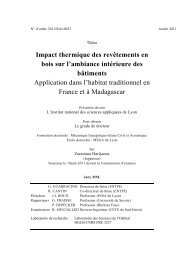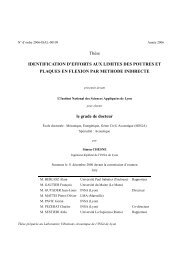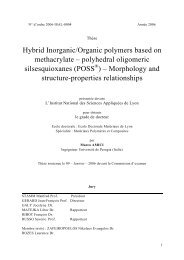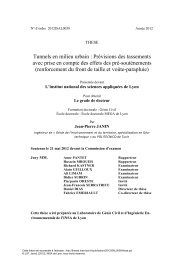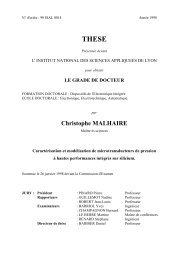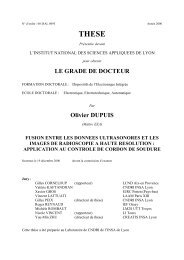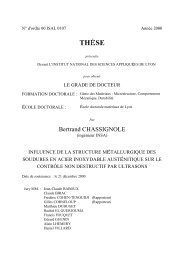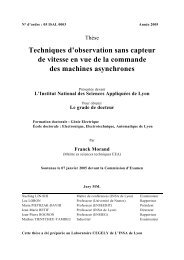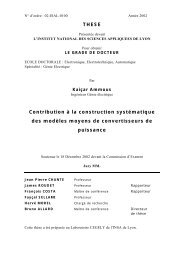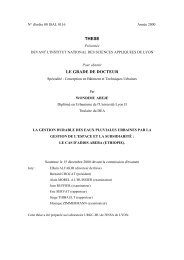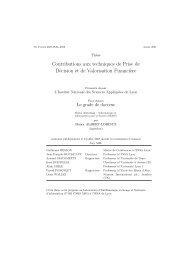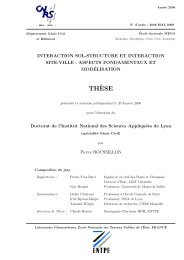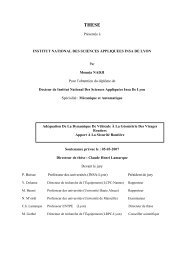Identification des mécanismes de fissuration dans un alliage d ...
Identification des mécanismes de fissuration dans un alliage d ...
Identification des mécanismes de fissuration dans un alliage d ...
Create successful ePaper yourself
Turn your PDF publications into a flip-book with our unique Google optimized e-Paper software.
98 Etu<strong>de</strong> <strong>de</strong> la <strong>fissuration</strong> sous chargement <strong>de</strong> fretting et <strong>de</strong> fatigue<br />
au point exact d’amorçage. On note cependant qu’il n’y a auc<strong>un</strong>e différence<br />
notable <strong>dans</strong> la position <strong><strong>de</strong>s</strong> joints entre les <strong>de</strong>ux coupes (pour mémoire Z ‖ L);<br />
la position <strong><strong>de</strong>s</strong> joints au point d’amorçage peut donc être déduite facilement.<br />
L’analyse <strong>de</strong> la position <strong><strong>de</strong>s</strong> joints <strong>de</strong> grains montre <strong>un</strong>e très bonne corrélation<br />
θa (˚)<br />
épaisseur <strong>de</strong> l’éprouvette (µm)<br />
◽<br />
◽ ◽<br />
◽ ◽<br />
◽ ◽<br />
0 100 200 300 400 500 600 700 800 900 1000<br />
90<br />
70 ◽<br />
◽<br />
◽ ◽<br />
◽<br />
50 ◽<br />
◽ ◽ ◽ ◽<br />
◽<br />
◽<br />
◽<br />
◽<br />
◽ ◽<br />
◽ ◽<br />
◽<br />
◽<br />
◽ ◽ ◽ ◽<br />
◽<br />
30<br />
◽<br />
10<br />
◽ ◽<br />
◽ ◽<br />
◽<br />
◽<br />
−10<br />
◽<br />
◽<br />
−30<br />
−50<br />
X<br />
Y<br />
Z = +30µm<br />
100µm<br />
Z = −30µm<br />
direction <strong>de</strong> propagation<br />
Fig. 3.27: Analyse <strong>de</strong> la position <strong><strong>de</strong>s</strong> joints <strong>de</strong> grain obtenue par mouillage<br />
au gallium et comparaison avec les angles d’amorçage en fretting observés<br />
par tomographie (voir le texte pour les explications).<br />
avec la limite entre les plateaux, et confirme donc l’hypothèse d’<strong>un</strong> amorçage<br />
multiple, suivi d’<strong>un</strong>e phase <strong>de</strong> coalescence. L’amorçage <strong>dans</strong> <strong>un</strong> grain est<br />
probablement corrélé à <strong>un</strong>e orientation cristallographique favorable vis avis<br />
<strong>de</strong> la sollicitation <strong>de</strong> contact. Des mesures EBSD ont été entreprises sur <strong><strong>de</strong>s</strong><br />
échantillons pour essayer <strong>de</strong> déterminer l’orientation cristallographique <strong><strong>de</strong>s</strong><br />
grains aboutissant à <strong>un</strong> amorçage en fretting, mais sans succès. En <strong>de</strong>hors <strong>de</strong> la<br />
difficulté <strong>de</strong> préparer (polir) la zone très proche <strong>de</strong> la surface sans arrondir le<br />
bord, il est apparu que l’écrouissage cyclique subi par le matériau lors <strong>de</strong> l’essai<br />
<strong>de</strong> fretting empêchait l’in<strong>de</strong>xation <strong><strong>de</strong>s</strong> figures <strong>de</strong> diffraction sur toute la zone



